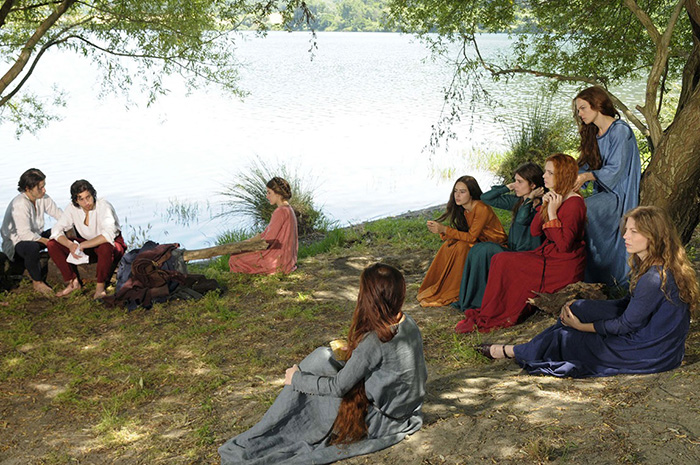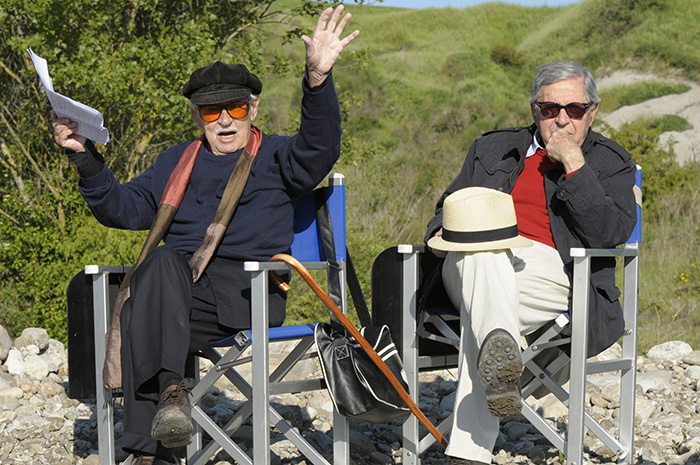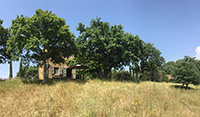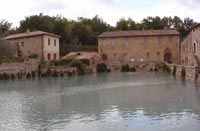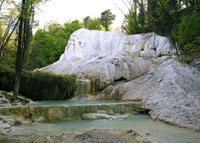| |
|
|
|
|
Maraviglioso Boccaccio | Wondrous Boccaccio | English trailer (2015)
|
|
Maraviglioso Boccaccio - Wondrous Boccaccio (2015) (Trailer) [1]
|
DIRECTORS’ NOTE
We tell this story, these stories, freely inspired by the “Decameron” by Boccaccio, because we wanted to take a challenge: to bring into opposition the pale colours of the plague – which, then as now, in various forms, is everywhere – to the transparent colours of love, ingenuity, poetry. We put this challenge in the hands of ten youngsters, seven women and three men, who will find strength by forming a community close to nature, with Franciscan rules, such as preparing their own bread. A choice of simplicity that allows them to look and plumb the complexity of human adventures, recalling them with the power of imagination.
|
Paolo and Vittorio Taviani
|
Directed by Paolo and Vittorio Taviani
Produced by Luigi Musini
Donatella Palermo
Screenplay by Paolo and Vittorio Taviani
Based on The Decameron by Giovanni Boccaccio
Starring Lello Arena, Paola Cortellesi, Carolina Crescentini
Music by Giuliano Taviani, Carmelo Travia
Cinematography Simone Zampagni
Edited by Roberto Perpignani
Distributed by Stemal Entertainment, Cinemaundici Film
Release dates February 20, 2015 (Florence premiere)
Running time120 minutes
Language Italian
SHOOTING LOCATIONS
Shot in Tuscany and Lazio, WONDROUS BOCCACCIO is set in the most enchanting places in Central Italy. In Tuscany, the shooting took place in the castle of Spedaletto and Tarugi tower in Pienza, the Piazza del Duomo in Pistoia, Castle of Potentino in the Monte Amiata region, in Badia a Settimo, in the municipality of Scandicci, in the Romitorio Montalcino castle and Nobili-Tarugi palace (attributed to Antonio da Sangallo the Elder) in Montepulciano, also in Villa La Sfacciata, overlooking Florence with a unique view. In Lazio, among the selected sets, there is the famous Odescalchi Castle in Bassano Romano, Montecalvello Castle, built by the Lombard King Desiderio and made famous by Balthus, the Abbey of Sant’Andrea in Fiumine and the Basilica of Sant’Elia.
Actors: Lello Arena, Paola Cortellesi, Carolina Crescentini, Flavio Parenti, Vittoria Puccini, Michele Riondino, Kim Rossi Stuart, Riccardo Scamarcio, Kasia Smutniak, Jasmine Trinca, Josafat Vagni, Melissa Bartolini, Eugenia Costantini, Moise Curia, Miriam Dalmazio, Camilla Diana, Nicolo Diana, Fabrizio Falco, Ilaria Giachi, Barbara Giordano, Rosabell Laurenti Sellers, Simone Ciampi, Lino Guanciale.
|
|

Poster[2]
|
Plot
|
The first story is set in Modena. Messer Gentile Garisendi is in love with Catalina, wife of Nicoluccio. She falls ill and her husband's mother fears that she has plague and will infect others in the household. She insists that she be taken away to the countryside to be cared for away from others. Her husband reluctantly agrees to this plan. On the trip, she dies. The carriage driver dumps her body off in a crypt at an abandoned church. Meanwhile, Gentile who had followed her carriage, sees her body in the crypt. He kisses her, and feels her heart beating. He takes her to his mother's villa where she is nursed back to health. He tells her that he wants to marry her. He invites a group of friends, including Nicoluccio, to see his chosen bride. He poses the question to the gathered group: a loyal servant falls ill and his patron abandons him. If another man picks up the servant, nurses him to health, shouldn't the second man be able to keep the servant? Nicoluccio answers, saying that the original patron has lost his right to have the servant and that he rightfully belongs to the second man. At that moment, Gentile reveals Catalina to the group, saying that she must decide between him and Nicoluccio. Nicoluccio, horrified, says she has come from hell. She looks at him, and says that no, I have come from paradise. She rejects him, remembering how he did not stay with her and turned her out in her illness.
In the second story: in Florence the oaf Calandrino apprentices in an art studio of a famous painter. Two of his fellow apprentices trick him by telling him of a stone that has the power to make people invisible. They go with him to the riverside to find such a stone. He finds one and they pretend that he is invisible. They convince their neighbors to play along with the ruse. Calendrino returns, carrying this stone, thinking that he is invisible, stealing gold from his neighbors' pouches, leering at a young woman, kicking the cane out from under the master painter. He arrives home and his wife, who doesn't know of the trick, looks at him and tells him his dinner is ready. He is horrified, believing that she has somehow cast a spell to drain the stone of its power. He accuses her of witchcraft and beats her. The story ends with her holding the stone above his head as he is eating at the dinner table.
Third story is set in Salerno. Duke Tancredi marries his daughter Ghismunda to a rich, older man. Soon after, the rich husband dies, and she falls in love with a handsome young man, a metal smith who works for her father. The father finds out, becomes enraged, and has him killed, later serving his heart to Ghismunda in a goblet of her lover's making. Ghismunda is torn by grief, and she melts the heart and adds poison to it. Ghismunda drinks the poison and dies.
City of Certaldo. One night, the nuns of the convent discover a nun in the arms of a man, and go to reveal this adultery to the mother superior. Unbeknownst to them, the mother superior is hiding her own lover in her chamber. So, in her hurry to dress, the mother superior confuses her headgear for the long johns of her lover. As she is passing judgment on the transgressing sister, her own secret is thus discovered by the nuns. At the end of the story, the mother superior is forced to pardon the sisters, and declares that God made everyone to have elements of sinners and saints within their souls, so each of them can bring lovers to the convent, as long as the news of the adulterers does not leave.
The last story: the knight Federico Alberighi is in in love with Giovanna, but she does not love him. He spends all his money in courtship and has nothing left but a falcon. She marries another man, with whom she has a son. Years later, the man dies and she moves to a villa, which happens to be near Federico's country property. Her son befriends Federico and begins to learn falconry. Her son falls ill and asks for the falcon as a gift. Giovanna goes to Federico's home to discuss this with him. While she is there, he realizes that he has nothing to serve Giovanna for dinner, and so he kills the beloved falcon to make her dinner. She realizes this, and is horrified. The son later dies and Giovanna moves away. Eventually, her brothers come to find Federico and tell him that the time has come for her to remarry, but she will have no other suitor but Federico. They ask if he will accept her offer and he does. [1]
|
|
|
|
Paolo and Vittorio Taviani
|
|
Paolo and Vittorio Taviani on the set of Wondrous Boccaccio
|
Paolo and Vittorio Taviani SELECTIVE FILMOGRAPHy
2015 Wondrous Boccaccio
2012 Cesar Must Die (Berlin 2012: Golden Bear, Prize of the Ecumenical Jury)
2007 The Lark Farm
2004 La Sanfelice (TV)
2001 Résurrection (TV)
1998 You Laugh (Two Kidnappings or Kaos II)
1996 The Elective Affinities
1993 Fiorile (Cannes 1993: in Competition; David di Donatello Awards: Best Production Design)
1990 Night Sun
1987 Good Morning Babylon
1984 Kaos (David di Donatello Awards 1985: Best Screenplay)
1982 Night of the Shooting Stars (Cannes 1982: Grand Prize of the Jury, Prize of the Ecumenical Jury; David di Donatello Awards 1983: Best Film, Best Directors, Best Cinematography, Best Editing)
1979 The Meadow
1977 Padre Padrone (Father and Master) (Berlin 1977: Grand Prix; Cannes 1977: Golden Palm, Fipresci Prize)
1974 Allonsanfan
1972 Saint Michael had a Rooster (Berlin 1972: Recommendation)
1969 Under the Sign of Scorpio
1967 The Subversives (Venice 1967: in Competition)
1963 Outlaws of Love
1962 A Man for Burning (Venice 1962: Pasinetti Award, Cinema 60 Award, New Cinema Award)
1960 Italy Is Not a Poor Country (documentary)
|
|
|
| |
|
References

[1] Maraviglioso Boccaccio - Wondrous Boccaccio (2015) (Trailer) (HD) from FILMARTI Film on Vimeo.
[2] By Source, Fair use, https://en.wikipedia.org/w/index.php?curid=46657336
|

Traveling in Tuscany | Films set in Tuscany
Wondrous Boccaccio at the Internet Movie Database
This article incorporates material from the Wikipedia article Wondrous Boccaccio published under the GNU Free Documentation License.
|


Podere Santa Pia is the ideal place to pass a very relaxing holiday in contemplation of nature. Waking up at dawn to start hiking, learning once again the names of flowers and trees, and above all, having the pleasure of getting lost, forgetting about guides, clocks and timetables
Located on the outskirts of Castiglioncello Bandini, in a hilly and unspoilt land, Podere Santa Pia is one of the best places to slow traveling in Tuscany. This formal cloister offers the quiet tranquility of a private retreat, with numerous attractions, beautiful nature reserves and beautiful beaches within easy reach. The most interesting artistic, historical and cultural sites of southern Tuscany are nearby, and are awaiting your discovery.
Tuscany's best kept secrets | Podere Santa Pia
|
| |
|
|
|
|
|
|
|
Podere Santa Pia |
|
Podere Santa Pia, garden |
|
Balthis' Montecalvello was the decor of
some scenes in Wondrous Boccaccio, (Paolo and Vittorio Taviani, 2015) |
| |
|
|
|
|
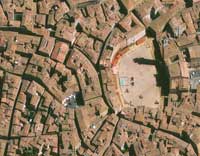
|
|
|
|
|
Siena, Piazza del Campo |
|
Florence, Duomo
|
|
Prato |
| Siena was the background for Palio, a gripping documentary by female director and Tuscan native Cosima Spender, about the Palio in Siena. |
|
Florence was the decor of Tea with Musolini (Un Tè con Mussolini, Franco Zeffirelli, 1999) |
|
Prato was the venue for Giuseppe Bertolucci's Berlinguer ti voglio Bene, where Roberto Benigni made his debut |
| |
|
|
|
|
|
|
|
|
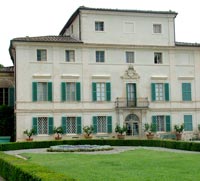 |
Bagno Vignoni |
|
Bagno San Filippo |
|
Villa Geggiano
|
| Bagno Vignoni was the location in which the majority of Andrei Tarkovsky's 1983 film Nostalghia were shot. |
|
Bagno San Filippo was the location in which parts of Alice Rohrwacher's 2014 film Le Meraviglie were shot. |
|
Villa di Geggiano è stato scelto nel corso degli anni per molte produzioni televisive e cinematografiche. Tra i più famosi utilizzo della Villa è stato per Io ballo da sola di Bernardo Bertolucci.
|
| |
|
|
|
|
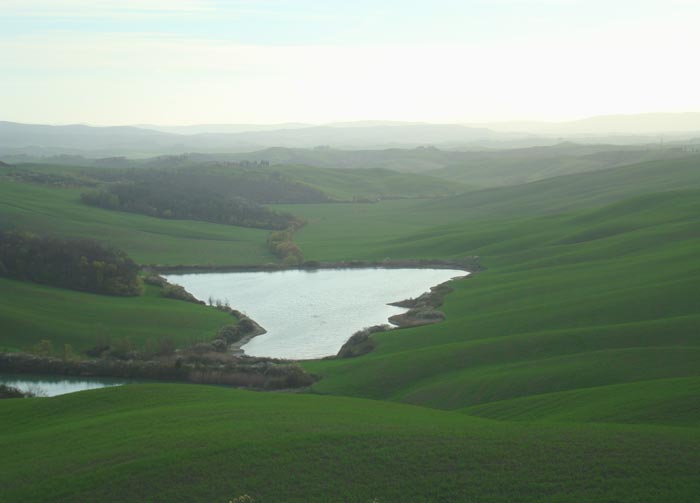 |
Crete Senesi, surroundings of Podere Santa Pia
|
|
|
|
